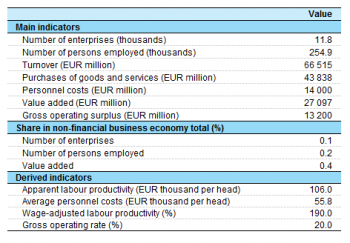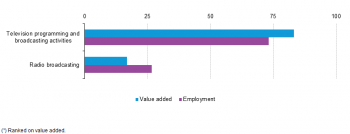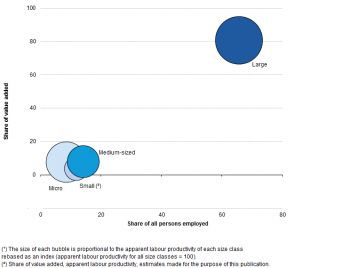Archive:Programming and broadcasting statistics - NACE Rev. 2
- Data from October 2015. Most recent data: Further Eurostat information, Main tables and Database.
This Statistics Explained article is outdated and has been archived - for recent articles on structural business statistics see here.
This article presents an overview of statistics for the radio and TV programming and broadcasting sector in the European Union (EU), as covered by NACE Rev. 2 Division 60. It belongs to a set of statistical articles on 'Business economy by sector'.


(% share of sectoral total) - Source: Eurostat (sbs_na_1a_se_r2)







(% share of sectoral total) - Source: Eurostat (sbs_sc_1b_se_r2)


Main statistical findings
Structural profile
There were 11.8 thousand enterprises operating with programming and broadcasting (Division 60) as their main activity in the EU-28 in 2012. Together they employed approximately 255 thousand persons, equivalent to 0.2 % of the non-financial business economy (Sections B to J and L to N and Division 95) workforce or 4.3 % of the information and communication services (Section J) workforce. EU-28 programming and broadcasting enterprises generated EUR 27.1 billion of value added in 2012, which was a 0.4 % share of the non-financial business economy total and a 5.2 % share of the information and communication services total.
The apparent labour productivity of the EU-28’s programming and broadcasting sector in 2012 was EUR 106.0 thousand per person employed, which was 2.3 times as high as the non-financial business economy average of EUR 46.2 thousand per person employed and also well above the information and communication services average of EUR 87. 0 thousand per person employed. This relatively high level of apparent labour productivity for the EU-28’s programming and broadcasting sector in 2012 meant that it ranked (according to this measure) as the ninth highest NACE division within the non-financial business economy.
Alongside high apparent labour productivity, average personnel costs for the EU-28’s programming and broadcasting sector in 2012 were also relatively high, at EUR 55.8 thousand per employee. Indeed, this was the eighth highest level of average personnel costs across all of the NACE divisions within the non-financial business economy and stood above the EUR 51.7 thousand per employee average for information and communication services and well above the EUR 32.4 thousand per employee average for the whole of the non-financial business economy.
Combining these two ratios, the wage-adjusted labour productivity ratio shows the extent to which value added per person employed covers average personnel costs per employee. Due to the high level of apparent labour productivity, the EU-28’s programming and broadcasting sector had a high wage-adjusted labour productivity ratio, 190.0 % in 2012, considerably higher than the information and communication services average (168.0 %) or the non-financial business economy average (142.7 %).
The gross operating rate (the relation between the gross operating surplus and turnover) is a measure of operating profitability; it stood at 20.0 % for the EU-28’s programming and broadcasting sector in 2012. This was 2.1 times as high as the non-financial business economy average (9.4 %) and close to the information and communication services average (20.3 %).
Sectoral analysis
The EU-28’s programming and broadcasting sector may be divided into two constituent parts, the larger of which covers television-related activities (Group 60.2), with the remainder of the sector made-up of radio-related activities (Group 60.1). Television programming and broadcasting activities accounted for 83.1 % of sectoral value added in 2012 and just under three quarters (73.2 %) of the sectoral workforce. On the other hand, there were 6.6 thousand enterprises operating as radio broadcasting enterprises across the EU-28 in 2012; approximately1.4 thousand more than were present operating within television programming and broadcasting activities.
The high apparent labour productivity figure for the whole of the EU-28’s programming and broadcasting sector was pulled upwards by the performance of television programming and broadcasting activities, where each person employed generated an average EUR 121.0 thousand of added value in 2012. Although average personnel costs (EUR 60.4 thousand per employee) were also relatively high, the combination of these two ratios led to a wage-adjusted labour productivity ratio of 200.0 % for television programming and broadcasting activities. This was considerably higher than the corresponding value for radio broadcasting, where the EU-28’s wage-adjusted labour productivity ratio was 160.0 % in 2012.
For the gross operating rate, there was little difference in the rates recorded by each subsector, with a rate of operating profitability for television programming and broadcasting activities at 19.6 % in 2012 and for radio broadcasting activities at 20.0 % in 2011, they were about twice as high as the non-financial business economy average (9.4 %).
Country analysis
Germany reported the highest level of value added generated within the programming and broadcasting sector in 2012 (EUR 6.8 billion); this equated to 25.2 % of the EU-28’s sectoral added value. The United Kingdom had the second highest level of value added (EUR 6.2 billion), while France and Italy were the only other Member States that recorded added value within the programming and broadcasting sector in excess of EUR 1.5 billion (EUR 3.8 billion and EUR 3.3 billion, respectively). Together these four Member States generated 74.2 % of the EU-28’s total value added in the programming and broadcasting sector in 2012.
In relative terms, the programming and broadcasting sector contributed as much as 0.9 % of national non-financial business economy value added in Poland in 2012; this share was considerably higher than in any of the other EU Member States; Croatia and the United Kingdom recorded a 0.6 % share, while Italy and Germany were also relatively specialised in the programming and broadcasting sector, as they contributed 0.5 % of their non-financial business economy value added. By contrast, the least specialised Member States included the Baltic Member States, Belgium, Slovenia and Slovakia (where the programming and broadcasting sector contributed no more than 0.1 % to non-financial business economy value added in 2012).
The highest wage-adjusted labour productivity ratio for the programming and broadcasting sector in 2012 was recorded in the Czech Republic (357.7 %); this figure was 2.4 times as high as the national average for the whole of the non-financial business economy. Poland and the United Kingdom also recorded relatively high wage-adjusted labour productivity ratios for the programming and broadcasting sector in 2012 (352.3 % and 319.8 %, respectively), which were 2.0 and 1.7 times as high as their national averages for the whole of the non-financial business economy.
The Czech figure was the third highest wage-adjusted labour productivity ratio recorded for the Czech Republic among any of the NACE divisions that compose the non-financial business economy, while the figure for Poland marked the fifth highest wage-adjusted labour productivity ratio in that country.
There were six EU Member States (among those for which data are available) with wage-adjusted labour productivity ratios for the programming and broadcasting sector below 100 %. These included Estonia, where the wage-adjusted labour productivity ratio was particularly low (75.6 %), while the others were Slovenia, Spain, Slovakia, Bulgaria and Sweden. Four of these Member States also recorded negative gross operating rates, -0.2 % for Bulgaria, -1.4 % for Slovakia, -3.8 % for Spain and -5.7 % for Estonia. At the other end of the scale, the highest gross operating rates for the programming and broadcasting sector were recorded in Poland (40.8 %), the United Kingdom (32.0 %) and Portugal (31.2 %), while Germany and the Czech Republic each reported operating profitability within the range of 25.0 % to 30.0 %.
Size class analysis
The relative importance of the 121 large enterprises (employing 250 or more persons) within the EU-28’s programming and broadcasting sector was considerable in 2012. Together they employed 167.3 thousand persons, which was close to two thirds (65.6 %) of the sectoral workforce. Their combined value added was EUR 21.9 billion, which equated to 80.8 % of the sectoral total. With a higher share of value added than employment, the apparent labour productivity of large enterprises within the EU-28’s programming and broadcasting sector was, at EUR 130.8 thousand per person employed, considerably higher than for the other size classes — approximately double the productivity level for medium-sized enterprises (employing 50 to 249 persons) and 1.4 times as high as for micro enterprises (employing fewer than 10 persons).
In the relatively small EU Member States of Estonia, Cyprus, Latvia, Lithuania, Luxembourg and Slovenia, small and medium-sized enterprises (SMEs) employed the whole of the programming and broadcasting activities workforce in 2012. It was, however, more common to find that the majority of the workforce was engaged by large enterprises. This was the case in the remaining 11 Member States for which data are available, with large enterprises accounting for an absolute majority (more than half) of the workforce in 9 of these. Large enterprises in France employed three quarters (74.8 %) of the workforce within the programming and broadcasting activities in 2012, while the share of large enterprises in the total workforce peaked at 80.6 % in Germany. Among the non-member countries for which data are available, large enterprises also employed a relatively high share of the programming and broadcasting activities workforce, some 78.7 % in Switzerland, rising to 84.5 % in Norway — the latter being higher than in any of the EU Member States. The share of large enterprises in the programming and broadcasting activities workforce was 18.9 percentage points higher in Norway than the corresponding share for the EU-28, which was the second highest difference across all of the NACE divisions that compose the non-financial business economy.
The relative importance of large enterprises was even greater in terms of their contribution to value added within the programming and broadcasting sector. Upwards of 80 % of the value added generated in France, Poland, Italy, Croatia, Spain, the United Kingdom and Romania was attributed to large enterprises, their share of sectoral value added peaking in Romania (90.5 %). By contrast, the 139 small enterprises operating within the French programming and broadcasting sector collectively reported negative value added; the same was true for the 1 375 micro enterprises within this sector in Spain and for the 162 micro enterprises in Sweden.
Data sources and availability
The analysis presented in this article is based on the main dataset for structural business statistics (SBS) and size class data, all of which are published annually.
The main series provides information for each EU Member State as well as a number of non-member countries at a detailed level according to the activity classification NACE. Data are available for a wide range of variables.
In structural business statistics, size classes are generally defined by the number of persons employed. A limited set of the standard structural business statistics variables (for example, the number of enterprises, turnover, persons employed and value added) are analysed by size class, mostly down to the three-digit (group) level of NACE. The main size classes used in this article for presenting the results are:
- small and medium-sized enterprises (SMEs): with 1 to 249 persons employed, further divided into;
- micro enterprises: with less than 10 persons employed;
- small enterprises: with 10 to 49 persons employed;
- medium-sized enterprises: with 50 to 249 persons employed;
- large enterprises: with 250 or more persons employed.
Context
This article presents an overview of statistics for the programming and broadcasting sector in the EU, as covered by NACE Rev. 2 Division 60. This division includes the activities of creating content or acquiring the right to distribute content and subsequently broadcast that content, for radio, television and data programs of entertainment, news, talk, and the like. Also included is data broadcasting, typically integrated with radio or TV broadcasting. The broadcasting can be performed using different technologies, over-the-air, via satellite, via a cable network or via internet. This division also includes the production of programmes that are typically narrowcast in nature (limited format, such as news, sports, education, and youth-oriented programming) on a subscription or fee basis, to a third party, for subsequent broadcasting to the public.
Radio broadcasting includes activities of broadcasting audio signals through radio broadcasting studios and facilities for the transmission of aural programming to the public, to affiliates or to subscribers. Also included are activities of radio networks (assembling and transmitting programming) and broadcasting over the internet.
Television programming and broadcasting activities include the activities of creating a complete television channel programme, from purchased or self-produced programme components or a combination thereof. The television channel can be either broadcast by the producing units or produced for transmission by a third party distributor, such as cable or satellite television providers. This activity includes video-on-demand channels.
This NACE division is composed of two groups:
- radio broadcasting (Group 60.1);
- television programming and broadcasting activities (Group 60.2).
Excluded are the production of television programme elements (movies, documentaries, talk shows, commercials and so on) not associated with broadcasting (Division 59, part of motion picture, video and television programme production, sound recording and music publishing activities) and the assembly of a package of channels and distribution of that package, without programming (Division 61, part of telecommunications), for example the distribution of cable and other subscription programming.
See also
- Information and communication services
- Other analyses of the business economy by NACE Rev. 2 sector
- Structural business statistics introduced
Further Eurostat information
Publications
- European business - facts and figures (online publication)
- Key figures on European Business – with a special feature section on SMEs – 2011 edition
Main tables
Database
- SBS – services (sbs_serv)
- Annual detailed enterprise statistics - services (sbs_na_serv)
- Annual detailed enterprise statistics for services (NACE Rev. 2 H-N and S95) (sbs_na_1a_se_r2)
- SMEs - Annual enterprise statistics by size class - services (sbs_sc_sc)
- Services by employment size class (NACE Rev. 2 H-N and S95) (sbs_sc_1b_se_r2)
- Annual detailed enterprise statistics - services (sbs_na_serv)
- SBS - regional data - all activities (sbs_r)
- SBS data by NUTS 2 regions and NACE Rev. 2 (from 2008 onwards) (sbs_r_nuts06_r2)
Dedicated section
Source data for tables and figures (MS Excel)
Other information
- Decision 1578/2007/EC of 11 December 2007 on the Community Statistical Programme 2008 to 2012
- Regulation (EC) No 295/2008 of 11 March 2008 concerning structural business statistics